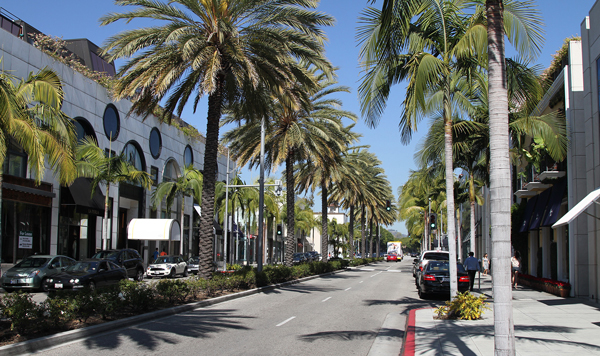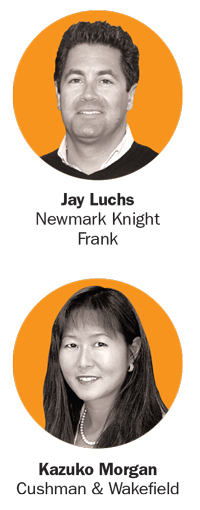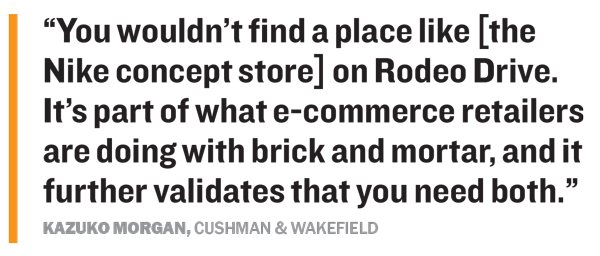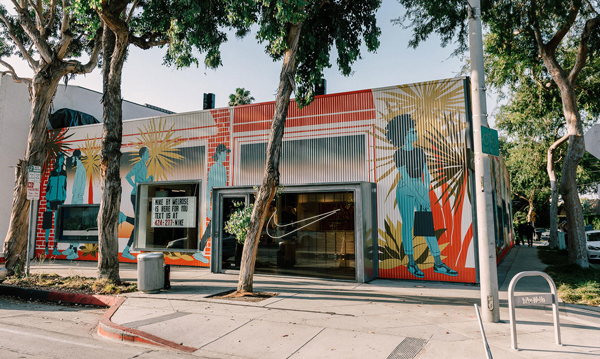Trending
The luxe life

Whether it’s the nine-digit property sales on Rodeo Drive or the “digital-meets-physical” experiences being created by tenants on Melrose Avenue, L.A.’s luxury retail corridors are hotbeds for high-profile activity that’s pushing rental rates up, up, up. That makes them clear outliers in a national retail market that’s largely suffering — so what gives?
There are a variety of reasons why Robertson, Melrose and Rodeo are thriving. For one, more affordable rental prices helped spark a comeback for the Robertson Boulevard district after a string of property sales, driving interest in the area and decreasing vacancy rates. Meanwhile, much of the retail industry is watching Melrose Avenue, where tenants are showing off new ways for brands to adapt to a digital world while keeping a brick-and-mortar presence relevant. And brokers said more high-end retailers are looking to invest in a long-term presence on Rodeo Drive, which recently welcomed some record-breaking sales for retail properties.
“Despite everything going on in retail in the country, these streets in L.A. have a lot of strong interest from tenants,” said Kazuko Morgan, a broker and vice chairman of retail brokerage services at Cushman & Wakefield.
“There’s only one Rodeo Drive”
Beverly Hills has been a brand name in and of itself for decades. And its centerpiece — or perhaps its raison d’être — has been and still is Rodeo Drive.
“It is still easily the most important street for luxury retail in California,” said Jay Luchs, listing broker and executive vice president at Newmark Knight Frank, who has secured several big-ticket deals on the street.

Rodeo Drive has one of the lowest vacancy rates around, and the average length of a lease is 10 years with five-year extension options, Luchs said. There are a couple spots available, “but it’s very tight right now,” he added.
Despite that, “demand is all over the place,” he added. “Six or seven years ago, there’d be three offers going for one listing. Now, it’s more one offer at a time, even though the street is getting better. But the interest is there, the offers are coming.”
Rodeo Drive has comfortably maintained its spot as the second most expensive shopping district in the nation — behind only Fifth Avenue in New York — according to rental values calculated by Cushman. The price per square foot on Rodeo Drive jumped in 2017 to $875 a year, up from $800 in 2016, and experts expect that rate to continue to climb, a recently released Cushman study showed.
For decades, the strategies of many top brands have included hanging a shingle on Rodeo Drive. The most revered luxury retailers — Versace, Chanel, Cartier, Tiffany & Co. and Gucci — showcase flagship stores along Rodeo Drive. Lacoste reopened a flagship on Rodeo in November.
But these shops are more than an exercise in branding. “It’s not true at all that they only care about putting their name there,” Luchs said. “I never once heard a buyer say they were hoping to just break even. They are there to make money, and they do.”
And according to area brokers and market watchers, these types of brands are increasingly looking to buy rather than lease, indicating that they want to be there for the long-term.
“Just look at who owns on that street,” Luchs said. “There have been eight to 10 landlords that have stuck together over the years and have made it a community on its own.”
In March, Louis Vuitton’s parent company, LVHM, paid$110 million for a one-story storefront at 456 North Rodeo Drive. Sterling Organization had owned the 6,200-square-foot property.
“It validates the huge commitment that owners are making to be on this street,” Cushman’s Morgan said of the LVHM purchase. “Just consider, [LVHM] already owns two other buildings on that strip.”

Two years ago, LVHM paid a record-breaking $122 million for a 6,290-square-foot space down the block, at 420 North Rodeo Drive, which was owned by Bijan. At $19,405 per square foot, the deal shattered the previous state record, which was set by Chanel when it paid $13,217 per square foot on the same strip in 2015. Further, LVHM also owns a store at 319-323 North Rodeo Drive, which it purchased in 2012.
But as LVHM doubled down, another retailer withdrew. In May, Brooks Brothers listed its double lot at 468 North Rodeo Drive with Luchs for a jaw-dropping $300 million. The property has been owned by a family trust for more than 50 years, and Brooks Brothers has occupied the spot since 2003. With frontage on Rodeo Drive and Santa Monica Boulevard, the property presents a development opportunity, Morgan added.
Luchs hinted that the property will sell and that he’s already fielding interest and discussing strong offers, but he couldn’t share specific details and said nothing is set yet.
Robertson’s rebound
The Robertson corridor has had its share of ups and downs over the past 20-odd years. From 2005 to 2007, Robertson Boulevard was becoming a strong alternative to Rodeo Drive. During those years, it was a magnet for celebrities such as Paris Hilton and Lindsay Lohan and the paparazzi that followed them.
“At its peak, it was one of the most sought-after locations,” Morgan said.
Because of that period, rental rates went up, said Gregory Briest, an associate broker at JLL who specializes in retail leasing for high-end luxury fashion brands. But rents shot up at the wrong time, as the recession was hitting. Thus, brands made a shift to Melrose Avenue, where prices were more manageable for risk-averse tenants. Robertson was hit hard during the recession, and 2008 was the last time Luchs had multiple offers for one space there, he said.
“There were vacancies for years,” Luchs said. “It’s still in recovery mode now. But lately, there have been a lot of positive changes for the first time in 10 years.”
Briest and Houman Mahboubi, an executive VP at JLL, said rates have now dropped to a more attainable level on Robertson, sparking a turnaround or a “rebirth.”
“The rents were just really overpriced for a few years,” Mahboubi said. “Anything that wasn’t food or fitness-based struggled. But now it looks like it’s coming back. I know some international brands from Australia and France are looking to set up there too.”
In April, Luchs helped James Perse luxury furniture and accessories secure the purchase of an 11,000-square-foot store on Robertson Boulevard to become the retailer’s flagship location. The store moved into 107-109 Robertson Boulevard, where Ralph Lauren used to have its flagship, though the location had been vacant for three years.
Mahboubi said the Perse store confirms that Robertson is “still very attractive.”
“There’s a lot of people who believe that this street can still do really well,” Mahboubi said.
The completed remodel of Robertson Plaza at 116 North Robertson Boulevard also helped jump-start the district’ so-called rebirth. It brought the openings of Blue Bottle Coffee and The Henry restaurant in the past year, and brokers think it will be a big catalyst for Robertson to make its comeback. Briest said the recent activity and interest around Robertson Plaza eased a lot of concerns about vacancies in the district.

Nike’s “concept shop” at 8552 Melrose Avenue, which opened July 12, allows customers to test products on a treadmill, pick up online orders and get alterations done.
Luchs said average deals on Robertson Boulevard are five years with an option for five more. Mahboubi said owners were asking too high a price when they were charging $120 to $145 per square foot per year. But in 2018, properties have been listed at about $85 to $145 per square foot annually.
Major moves on Melrose Avenue
Rodeo Drive’s biggest local competition for high-end tenants is the district along Melrose Avenue in West Hollywood, experts said. Luchs described Melrose as L.A.’s version of Soho, adding that it “has a younger vibe, but it still has wealth.”
“That strip is really important in the fashion world,” he said. “I tell all my clients they need a store there first, and to worry about going somewhere else after. If you’re going for the young crowd, you need to be in West Hollywood.”
Morgan said the stores on Melrose aren’t as large as those on Rodeo, “but they still cater to luxury customers.”
And the corridor has benefited from tenants moving from Robertson Boulevard a few years ago, Briest noted.
Nike made the most recent splash in the district when it secured more than 4,500 square feet at 8552 Melrose Avenue for its new “concept shop,” according to Carine Mamann, a broker at Cushman.
The “digital-meets-physical” pilot location opened July 12 and it’s inspired by Nike’s mobile shopping app, Mamann said. It focuses on customer service over specific inventory, and shoppers can pick up or exchange items, coordinate with store employees via text, test products on a treadmill and get styling advice and alterations.
Morgan said the new strategy shows how brands are adapting by integrating experiences to complement online shopping.
“You wouldn’t find a place like that on Rodeo Drive,” Morgan said. “It’s part of what e-commerce retailers are doing with brick and mortar, and it further validates that you need both.”
Experience-based retail shops are expected to proliferate, according to a recent Cushman retail report.
Briest pointed to U.K.-based brand PrettyLittleThing, which is opening its first brick-and-mortar shop in L.A. at 8587 Melrose Avenue, near AllSaints, and other fashion labels such as Zadig & Voltaire, Rag & Bone and Lululemon. Though PrettyLittleThing will hold a prime retail space, it’s not technically retail, Briest said. It will have some ground floor retail, but will otherwise act as a headquarters for the company, including a photo studio, lounge, private showroom and workspace.
In March, a joint venture of Guggenheim Real Estate and L3 Capital paid $23 million for a Melrose Avenue retail property that is home to fashion brands such as Theory and Serena & Lily. The 11,300-square-foot-property at 8420-8430 Melrose Avenue — sold at more than $2,000 per square foot — was owned by Malibu-based American Commercial Equities.
Morgan said that a wealth of development activity happening behind Melrose will also be good news for the corridor.
Construction started in March for Charles Co.’s Melrose Triangle complex in West Hollywood. The mixed-use project at 9060 Santa Monica Boulevard will include 82,000 square feet of ground-floor retail and it is scheduled to be complete by 2020.
Briest said the mixed-use project will help energize the area even more.
Morgan and JLL’s Mahboubi both estimated that rents on Melrose Avenue are $145 to $240 per square foot a year, with some deals as high as $300 per square foot a year.
Mahboubi and Luchs both said that some owners have been trying pop-up shops on Melrose and asking for one- to two-year deals to see if their stores work out. But Luchs said that after a slow period, the average lease on Melrose Avenue is back to 10 years.
“Now you can see that tenants want to be in these places long-term,” Luchs said.




